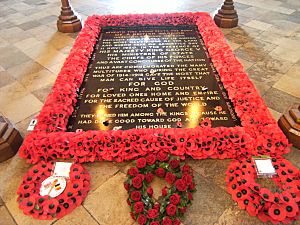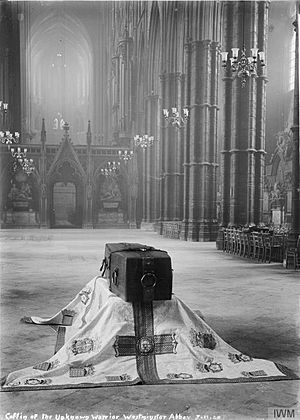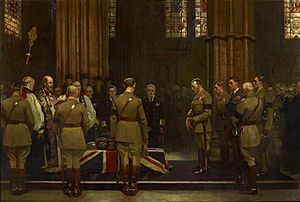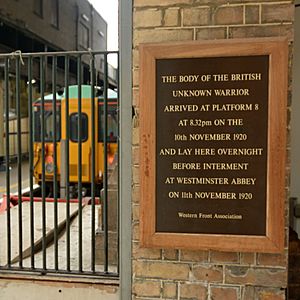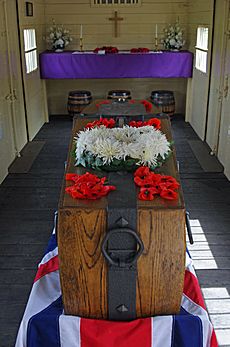The Unknown Warrior facts for kids
The Unknown Warrior is a special soldier from the First World War whose identity is not known. This brave person was part of the British Empire armed forces. They died on the Western Front, which was a major battle area.
The Unknown Warrior is buried in a famous grave at Westminster Abbey in London. This grave is also called the Tomb of the Unknown Warrior. On November 11, 1920, a big funeral was held for this warrior. At the same time, a similar unknown soldier was buried in France at the Arc de Triomphe. These two graves were the very first "tombs of the unknown soldier." They were created to honor all the soldiers who died in the First World War and could not be identified.
The name "Warrior" was chosen instead of "Soldier" because the person could have been from the army, navy, or air force. They could also have come from any part of the British Empire at that time. However, it is believed the warrior was most likely a soldier from the British Isles.
Contents
History of the Unknown Warrior
How the Idea Started
The idea for the Tomb of the Unknown Warrior came from a man named David Railton. He was an army chaplain during the First World War. In 1916, while serving on the Western Front, he saw a simple grave. It had a rough cross with the words 'An Unknown British Soldier' written on it.
In 1920, Railton wrote to Herbert Ryle, the head of Westminster Abbey. He suggested that an unidentified British soldier from the battlefields in France be buried in the Abbey. This would be a way to honor the hundreds of thousands of soldiers from the British Empire who died. The idea was strongly supported by Herbert Ryle and the Prime Minister, David Lloyd George. Lloyd George said the grave was a sign of the nation's sadness for all who were lost.
Choosing and Bringing the Warrior Home
Lord Curzon was in charge of planning the ceremony. Bodies of soldiers were carefully dug up from different battlefields in France. On November 8, 1920, they were brought to a chapel near Arras, France. Two officers, Brigadier L.J. Wyatt and Lieutenant Colonel E.A.S. Gell, went into the chapel alone. They placed the remains into four plain coffins, each covered with a Union Flag. The officers did not know which battlefield each soldier came from. Brigadier Wyatt, with his eyes closed, chose one of the coffins. The other soldiers were then reburied.
The chosen coffin stayed in the chapel overnight. On November 9, it was moved to a medieval castle in Boulogne. The castle library was turned into a special room for the coffin. French soldiers stood guard all night.
The next morning, the coffin was placed inside a special casket. This casket was made from oak trees from Hampton Court Palace. It was decorated with iron bands. A 16th-century sword, chosen by King George V himself, was placed on top. An iron shield on the casket read: 'A British Warrior who fell in the Great War 1914–1918 for King and Country'.
The casket was then put on a French military wagon pulled by six black horses. At 10:30 a.m., all the church bells in Boulogne rang. French trumpets played a special tune. A long procession, including 1,000 schoolchildren, went to the harbor.
At the harbor, Marshal Foch saluted the casket. It was then carried onto the destroyer ship, HMS Verdun. The Verdun left the harbor just before noon. Six other destroyers joined it as escorts. As the ships neared Dover Castle, they received a 19-gun salute. The casket was brought ashore at Dover Marine Railway Station on November 10.
The body of the Unknown Warrior was then taken to London by train. The train car, No.132, had also carried the bodies of Edith Cavell and Charles Fryatt. This historic train car is now preserved by the Kent and East Sussex Railway. The train arrived at Victoria Station at 8:32 p.m. and stayed there overnight. A plaque marks the spot where it rested. Every year on November 10, a small service is held there.
The State Funeral and Burial
The Unknown Warrior was given a full state funeral. This was a very rare honor for an anonymous person. On the morning of November 11, 1920, the casket was placed on a gun carriage. Six black horses pulled it through huge, silent crowds. Another salute was fired in Hyde Park.
The procession went to Whitehall, where the Cenotaph was unveiled by King George V. The Cenotaph is a "symbolic empty tomb." The King, the Royal Family, and government ministers followed the casket to Westminster Abbey. The casket was carried into the Abbey by a guard of honor. This guard was made up of 100 people who had received the Victoria Cross, a very brave award.
Special guests at the funeral were about 100 women. They had been chosen because each had lost their husband and all their sons in the war. The coffin was buried at the far western end of the Abbey's main area. Soil from the main battlefields was placed in the grave. The grave was covered with a silk cloth. Soldiers stood guard as thousands of mourners walked silently past. This ceremony helped many people deal with their sadness from the war.
The grave was then covered with a black marble stone. This stone is the only one in the Abbey that people are not allowed to walk on. The words on the stone were written by Herbert Edward Ryle, the Dean of Westminster. The brass letters were made from melted-down wartime ammunition.
Beneath this stone rests the body
Of a British warrior
Unknown by name or rank
Brought from France to lie among
The most illustrious of the land
And buried here on Armistice Day
11 Nov: 1920, in the presence of
His Majesty King George V
His Ministers of State
The Chiefs of his forces
And a vast concourse of the nationThus are commemorated the many
Multitudes who during the Great
War of 1914 – 1918 gave the most that
Man can give life itself
For God
For King and country
For loved ones home and empire
For the sacred cause of justice and
The freedom of the worldThey buried him among the kings because he
Had done good toward God and toward
His house
Around the main words, there are four quotes from the New Testament (part of the Bible):
- "The Lord knoweth them that are his"
- "Unknown and yet well known, dying and behold we live"
- "Greater love hath no man than this"
- "In Christ shall all be made alive"
Later History and Tributes
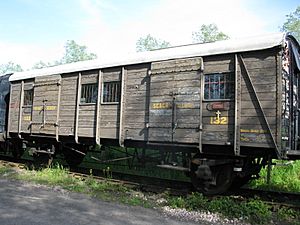
A year later, on October 17, 1921, the Unknown Warrior received the Medal of Honor. This is the highest award for bravery from the United States. General John Pershing presented it. The medal now hangs near the tomb. On November 11, 1921, the American Unknown Soldier was given the Victoria Cross in return.
When Elizabeth Bowes-Lyon (who later became Queen Elizabeth The Queen Mother) married Prince Albert in 1923, she placed her wedding bouquet on the Tomb. This was a tribute to her brother Fergus, who died in the war. Since then, royal brides who marry at the Abbey or elsewhere often place their bouquets on the tomb the day after their wedding.
Before she passed away in 2002, Queen Elizabeth The Queen Mother asked for her wreath to be placed on the Tomb of the Unknown Warrior. Her daughter, Queen Elizabeth II, laid the wreath the day after the funeral.
The British Unknown Warrior was ranked 76th in a poll of the 100 Great Britons. A new steam locomotive, LMS Patriot Class 5551 The Unknown Warrior, is being built. It is meant to be a new national memorial engine. Work on this locomotive started in 2008 and is still ongoing.
Leaders from over 70 countries have placed wreaths at the tomb to honor the Unknown Warrior.
On the 100th anniversary of the burial in 2020, a special ceremony was held at the Abbey. Prince Charles (now Charles III), his wife Camilla, and the Prime Minister, Boris Johnson, attended. The Poet Laureate, Simon Armitage, read a new poem. Queen Elizabeth II also laid a wreath at the tomb.
Related Memorials
Since 1920, three other memorials have been put up for the Unknown Warrior:
- In St. Pol, France, where the Unknown Warrior was chosen.
- At Dover harbor, where the Unknown Warrior was brought ashore.
- At Victoria Station in London, where the Unknown Warrior rested before the burial.


